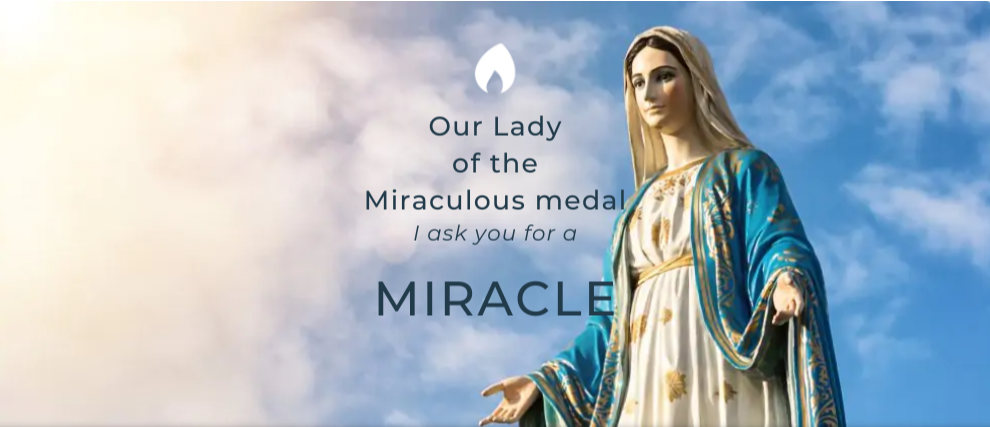The Apparitions on Rue du Bac
The apparitions on Rue du Bac took place in 1830. A young novice with the Daughters of Charity, Catherine Labouré saw the Blessed Virgin three times in the chapel of the Sisters. These three appearances had a dazzling impact first in Paris, then throughout France, and very quickly all over the world. The Virgin Mary gave a message and a new source of thanks during these apparitions: the miraculous medal. Sister Catherine Labouré gave a detailed account of the apparitions that took place in the chapel on Rue du Bac.
The account of the first apparition by Sister Catherine Labouré
The evening of July 18, 1830 was the eve of the feast of Saint Vincent de Paul, founder of the Daughters of Charity. Catherine Labouré was particularly attached to him, and she had had visions of his heart. She begged him to obtain the grace that she yearned for: to see the Blessed Virgin. She recounts: “I fell asleep thinking that Saint Vincent would give me this grace. Around 11:30 I heard myself called by my name, a four- or five-year-old child dressed in white said to me "Come to the chapel, the Blessed Virgin is waiting for you". Around midnight the child told me twice "Here is the Blessed Virgin", so I heard a noise like the swishing of a silk dress. A very beautiful lady sat in the director's chair. I jumped to her and put my hands on her knees. ” During this first apparition, the Blessed Virgin told the young Catherine how she should behave towards her director and entrusted her with several things.
It was only many years later, in 1876, that a few months before Sister Catherine died, that she recounted these things that the Mother of God entrusted to her. The message came in a form of prophecy: “The Good Lord my child wants to entrust you with a mission. It will be the cause of much pain, but you will overcome in the knowledge that you are doing it for the glory of God, you will be contradicted but you will have grace, do not fear, you will see certain things, times are hard, misfortunes will fall on France, the throne will be overthrown, the whole world will be overthrown by misfortunes of all kinds, but come to the foot of this altar, there the graces will be poured out on all those who will ask for them with confidence and fervor, and they will be poured out on the great and on the small ". Sister Catherine specified that at the end of the apparition, the Virgin disappeared like a light that is extinguished.
The second appearance of rue du Bac
On November 27, 1830, Sister Catherine had the revelation of the mission of which the Virgin had spoken to her. The Virgin appeared to her this time during the novice prayer. Here is the account she gave: "I saw the Blessed Virgin, she was standing dressed in an aurora white silk dress, her feet resting on a ball of which I could only see half. In her hands raised to the height of her chest, she held a globe, her eyes raised to the sky. Suddenly I saw on her fingers rings covered with stones that threw rays more beautiful, each more beautiful than the last. At this moment, the Virgin looked down at me: "this globe that you see represents the whole world, especially France and each person in particular", and speaking of the rays starting from its rings: "it is the symbol of the graces that I pour out on the people who ask me for them."
At this moment Catherine saw the formation of an oval-shaped painting around the Blessed Virgin, with these words written in golden letters "O Mary conceived without sin pray for us who have recourse to you". The young sister then heard: "Strike a medal on this model, the people who wear it will receive great graces, graces will be abundant for those who trust." The young nun noticed that some precious stones gave no rays and heard: "These stones that remain in the shadows are the graces that are forgotten to ask me." At this moment the picture appeared to turn, and Sister Catherine saw the reverse of the medal: the letter M surmounted by a cross and beneath two hearts, one surrounded by a crown of thorn and the other pierced with a sword. One voice said, "M and both hearts say enough, Mary, Jesus two sufferings united for our redemption."
Thus, during this second apparition, the Mother of God gave Sister Catherine Labouré the model of the medal she wished to see made and worn by all. A statue of the Virgin in the Globe as she appeared to Catherine is in the chapel.
The Third Appearance of the Virgin Mary
In December 1830, the Blessed Virgin appeared for the last time to Sister Catherine Labouré. This time she appeared at the tabernacle of the chapel, behind the altar. The Virgin came to confirm her mission and say goodbye to her, "You will not see me anymore." Sister Catherine lived the rest of her life as a humble nun, discreet and devoted to the elderly and the sick, whom she served for 42 years. It was not revealed during her lifetime that she had received special graces and was at the origin of the devotion of the miraculous medal. Living in isolation in Enghien's hospice, she served Christ in the poor.
The Recognition of Apparitions and the Immaculate Conception
In 1835, faced with the blazing spread of the miraculous medal and the miracles that accompanied it, the archbishop of Paris decided to open a canonical trial to examine the authenticity of the apparitions. This trial was supposed to follow a usual procedure, which could not take place because Catherine Labouré wanted to remain anonymous and silent. The trial therefore remained unfinished. In 1842, an unexpected event refocused attention on the apparitions of Rue du Bac. Alphonse Regensburg, a young Jewish banker, agreed to keep the medal in his pocket. The next day, the Virgin of the Miraculous Medal appeared to him. Being a known personality, his sudden conversion has an immense impact. It is this apparition that was the subject of a canonical process leading to the official recognition of the apparitions of the Virgin Mary to Catherine Labouré.
In 1854, Pius IX defined the dogma of the Immaculate Conception by referring to the Virgin of the miraculous medal, "She appeared in the world, with her Immaculate Conception, as a splendid dawn that spreads its rays on all sides".
In 1894, Leo XIII approved the Mass for the feast of Our Lady of the Miraculous Medal, composed by the Lazarists, and in 1897, he granted the coronation of the statue of the Immaculate Conception, known as the Miraculous Medal.
In 1947, Pius XII declared Catherine Labouré a saint.

